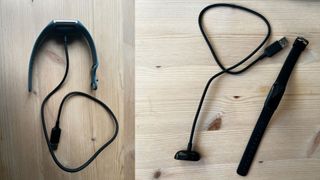Fitbit Luxe vs Charge 5: What's the difference and which is better?
Digital health editor Grace Walsh weighs up the Fitbit Luxe vs Charge 5 for fitness fans


Weighing up the Fitbit Luxe vs Charge 5 for your next upgrade? You won't be the only one this season. While Fitbit upgrades its devices fairly regularly, these two stylish trackers have captured the attention of brand fans since their release last year.
The Fitbit Luxe was designed to be a watch for fashion-conscious people looking to improve their overall wellbeing, with a discreet design and various strap varieties to choose from. In favor of these aesthetics, however, the brand dropped some key fitness-tracking features and sensors. While the Fitbit Charge 5 is less concerned about aesthetics and better suited for those who want to track every detail of their wellness and fitness routines, it is very similar to the Luxe in many ways.
Nevertheless, as undoubtedly two of the best Fitbits to buy right now, the Fitbit Luxe and the Fitbit Charge 5 both promise exciting features and innovative designs to make keeping tabs on your fitness and overall wellness easier. But which one is better? I've tried and tested both devices to offer a detailed overview of the two and a final answer to the question.
Fitbit Luxe vs Charge 5
Features

The Fitbit Charge (left) is slightly bigger than the Fitbit Luxe (right).
The Luxe and the Charge 5 are the same types of Fitbit as they are both fitness trackers rather than smartwatches. This means their features generally focus more on the basics of fitness tracking rather than being highly compatible with iOS or Android smartphones. However, they still have plenty of useful elements outside of the fitness space.
For example, both have a timer you can set from your wrist and offer alarm functions that make your watch buzz at a chosen time. They both also have a Find My Phone function and enable call, text, and calendar notifications when connected to your phone. Neither allows you to answer the messages or calls on your wrist but you can view and dismiss them. If you're weighing up Fitbits vs Apple Watches, this is something to consider.
However, the Charge 5 has a couple of additional features - such as Fitbit Pay capabilities. It's not a widely supported payment method in the UK or the US but it's also not a feature that the Luxe offers - despite being positioned as a lifestyle watch as well as a fitness tracker. Fitbit's Charge 5 also has a 'Sleep' mode that quiets your watch during specific hours, meaning you can still have it on for sleep tracking without having to worry about unwelcome text messages waking you up, while the Luxe just has a 'Do Not Disturb' mode.
When it comes to battery life, the Fitbit Charge 5 wins out too. Both devices take a full two hours to fully charge and use the same magnetic USB charging cable but, in my experience and from the brand's specifications, the Charge 5 will last for seven days with that juice while the Luxe peters out after just five. It's a worthwhile factor to consider when weighing up the Fitbit Luxe vs Charge 5, especially if you're going to be using it alongside GPS.
Sign up for the woman&home newsletter
Sign up to our free daily email for the latest royal and entertainment news, interesting opinion, expert advice on styling and beauty trends, and no-nonsense guides to the health and wellness questions you want answered.

The Fitbit Charge (left) and Fitbit Luxe (right) have the same magnetic USB charging cable.
Fitness tracking
When it comes to weighing up Fitbit Luxe vs Charge 5, it's all about the fitness tracking features. Both devices will offer all the essentials - such as heart rate monitoring, steps, calorie burn, 20 different exercise modes to choose from, and Active Zone Minutes - but the Charge 5 has more both on the wrist and in the Fitbit app.
It has built-in GPS for instance, meaning you can leave your phone at home and still head track your distance, pace, and route via the app, whereas the Luxe requires a connected phone for this. While it may not be an integral feature for everyone, especially if you're more into gym-based training than running or cycling, I really noticed the difference when I didn't have it.
The Charge 5 has an electrodermal activity (EDA) sensor too, an integral feature only available on this model and the Fitbit Sense 2, the newest Fitbit. It's a great one for anyone looking to lower their daily stress levels as the sensor allows your device to pick up minor changes in adrenal activity via the skin, sending out responses based on how much the activity changes.
It's also the only device of the two that comes with an electrocardiogram (ECG) sensor, a feature that allows you to monitor your heart rhythm for atrial fibrillation - a type of heart rhythm irregularity. Once the statistics have synced with your app, you can then share them with your doctor. Thanks to the standard heart rate tracking technology in both devices, however, the Luxe will flag any irregular heart rhythms.
Both are relatively similar when it comes to value for money with the Premium subscription. While the Fitbit app is free for any user to download, those looking for more statistics can pay $9.99/£7.99 per month for more detailed insights into everything from sleep to stress, fitness, cardio capabilities, and more. In both cases, a Daily Readiness Score is available through the Premium version, which aims to rival the WHOOP 4.0 as it offers a score based on how well-rested you are from the last bout of exercise.

Display
A flick of the wrist will bring the display on both the Fitbit Luxe and Charge 5 to life, provided you've not got the 'always on' setting enabled, and both devices have a bright, full-color AMOLED display and touchscreen which naturally dims and brightens depending on the surrounding sunlight.
The only real difference between the two in terms of the display is the size. As the Luxe is made to be a more discreet watch, ideal for replacing your regular timekeeper or complementing another accessory, it's a little smaller at 0.74 inches diagonally across while the Charge 5 offers a larger viewing at 1.04 inches across. It may not seem like a lot but, in my experience testing these two devices, you really notice the difference. Not only is the touchscreen harder to navigate on the Luxe, from enabling a workout or stopping one to setting a timer, but the size of notifications is also significantly smaller. As noted, this seems somewhat counterintuitive considering its role as a regular wearable alongside a fitness tracker.
If you want to learn how to change the time on a Fitbit, it's exactly the same on both devices so this doesn't need to factor into your decision-making process. In both cases, you'll need to download the Fitbit app.
Design
The Fitbit Luxe definitely has a sleeker design that's made to blend into the background rather than make a style statement. It fits neatly on the wrist with a thin silicone band and is available in lunar white, black, pink, or special edition soft gold. The watch face is wrapped in stainless steel in either black or gold, and hardly noticeable.
The Charge 5, on the other hand, isn't only physically bigger but comes with a more imposing, thick rectangular screen that pushes out from the strap on your wrist. It's available in similar colors to the Luxe though, with black and lunar white among the three options for the wrist strap. There are also three metallic options available for the stainless steel casing on the Luxe.
The straps are fully customizable on both designs as well, so if you opt for one color and want to change sometime later, Fitbit has a range of straps that fit the Fitbit Luxe and Charge 5, including ones made of leather, metal, woven fabric, and other silicone patterns.

The Fitbit Luxe (left) is also available with a limited edition gold strap and the Fitbit Charge 5 (right) comes in various colors.
Price
There's a $10 / £60 price difference between the Fitbit Charge 5 ($149.95 / £169.99) and the Fitbit Luxe ($139.95 / £109.99). If you're buying from the US, this really isn't a lot considering the vast differences in fitness-tracking capabilities and other features, but the price is a little more of an adjustment if you're buying from the UK.
When the best Fitbit deals come through, it's almost always the Fitbit Luxe that goes on sale rather than the Charge 5 so if that one's your preference, you can often pick up the device for even cheaper.
Which is better?
In my opinion, after testing and reviewing both devices for a couple of weeks each, the Fitbit Charge 5 is a better buy overall. It may be slightly more expensive than the Fitbit Luxe and it might be missing the same stylish aesthetics, but it's one of the best fitness trackers on the market right now. Whereas the Luxe is better looking, it's lacking in some very important features for monitoring both fitness and overall wellness, namely: built-in GPS, ECG, and EDA sensors.

Grace Walsh is woman&home's Health Channel Editor, working across the areas of fitness, nutrition, sleep, mental health, relationships, and sex. She is also a qualified fitness instructor. In 2024, she will be taking on her second marathon in Rome, cycling from Manchester to London (350km) for charity, and qualifying as a certified personal trainer and nutrition coach.
A digital journalist with over six years experience as a writer and editor for UK publications, Grace has covered (almost) everything in the world of health and wellbeing with bylines in Cosmopolitan, Red, The i Paper, GoodtoKnow, and more.
-
 We've just found a brilliant M&S lookalike for 2024's answer to the Birkin bag - and it's less than £40
We've just found a brilliant M&S lookalike for 2024's answer to the Birkin bag - and it's less than £40The Row's Margaux bag is a celeb style staple, but this M&S alternative is a fraction of the eye-watering original price
By Amelia Yeomans Published
-
 The Young Woman and the Sea: Did Trudy Ederle really swim through jellyfish?
The Young Woman and the Sea: Did Trudy Ederle really swim through jellyfish?The Young Woman and the Sea has got viewers wanting to know more about Trudy Ederle's adventure across the Channel
By Katherine Sidnell Published